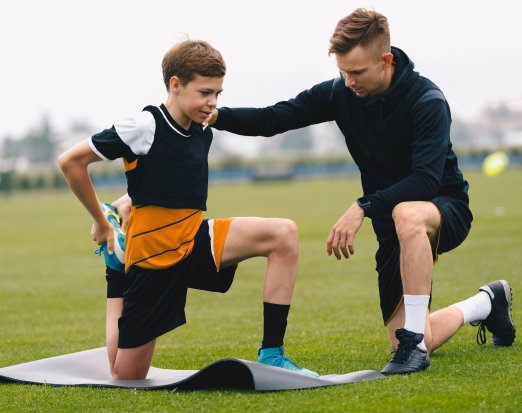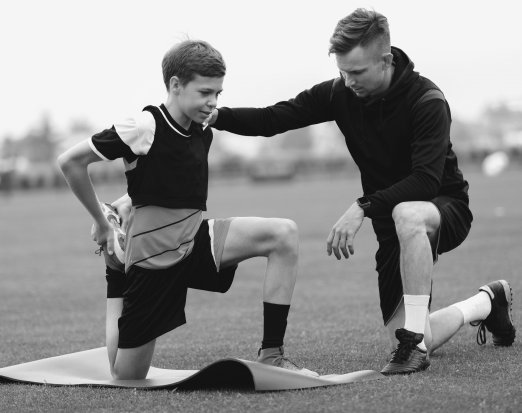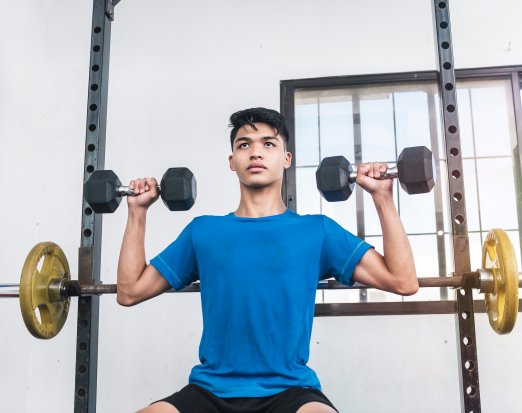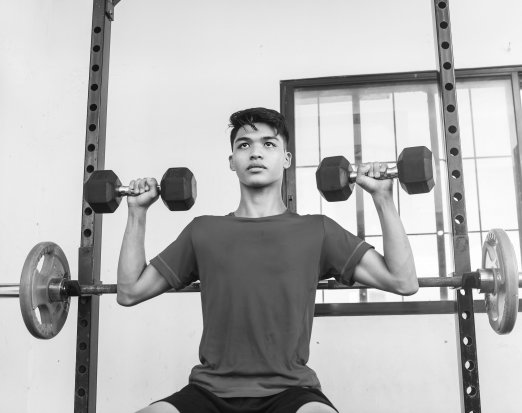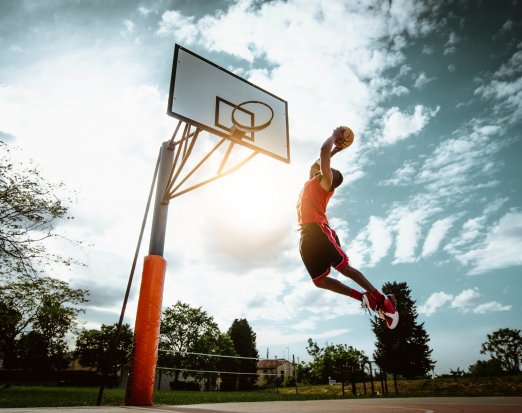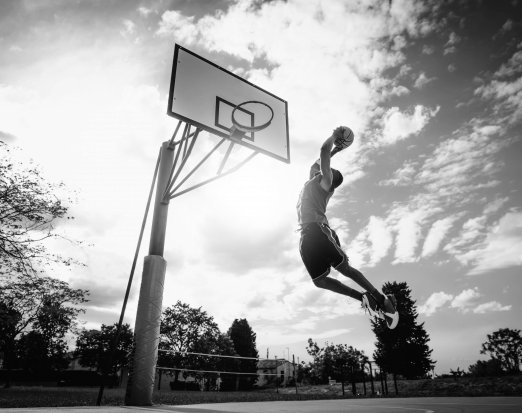Youth Training - Sports Specific Training
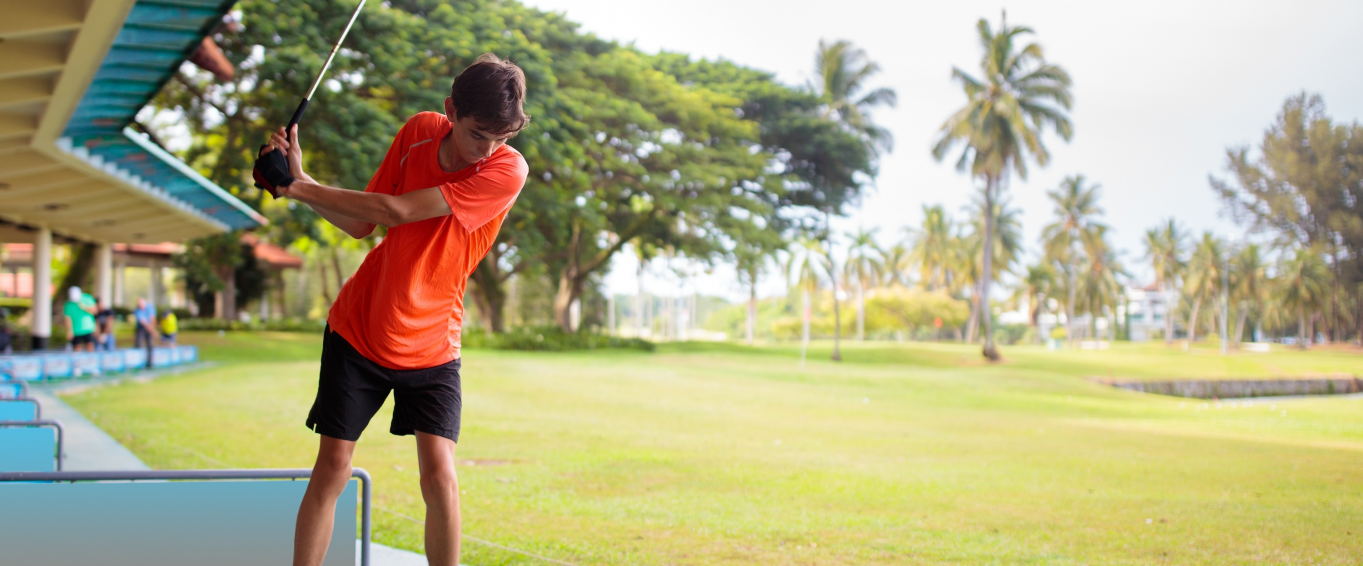
From a training perspective, all athletes regardless of their experience and sporting ability perform regular training, away from their sport, to either maintain or improve sporting performances (reducing the risk of injury is important too, but most athletes are looking for that sporting improvement). Therefore, physical training (strength and conditioning), has clear aims or objectives of trying to enhance physical qualities. Physical qualities being a broad range of fitness elements – strength, hypertrophy, mobility, movement skills, energy requirements, agility, power, and speed. Moreover, by enhancing the physical qualities this will aid in the development of performance characteristics – for example, acceleration, jump ability, and agility – this highlights and stresses the importance and why all coaches should test and monitor their athletes, as the coach can then analyse the effectiveness of the training block or cycle.
As most coaches and athletes are investing time and effort into greater or higher sporting performances, exercise selection is an important decision surrounding their physical development and cycle of training. Exercise selection is a huge debate within the strength and conditioning community, with the discussion usually falling into two major camps – sport-specific training – with the thinking that if the exercise looks like the sport or has the similar movement patterns a greater transfer may occur (1). Conversely, the other line of thinking is that training can be mostly general, with some training becoming more specific (through a change in velocity) as the athlete develops (3, 16) – hence the terms – general strength, general adaptation phase, and general adaptation syndrome.
Clearly, there is no absolute right or wrong, as all training can be classified as further practice and will lead to adaptations (relative to the training load and volume). However, as strength and conditioning coaches have limited time with their athletes, it could be argued that exercise selection could help to utilise that time effectively. As previously mentioned, the main idea surrounding sport-specific training is that the exercises tend to look like the sport (movement patterns), as the belief or claim is that the training effect will transfer or carryover to the sport. Examples here could be unstable training for skating, ice-hockey, BMX athlete, or rotational exercises for golf or tennis players. Furthermore, functional training could be considered a subcomponent of sport-specific training, as the ideas are closely related, with exercises being classified as either functional or non-functional, with the functional training having a large emphasis of recruiting the core (9) (you can read more about core stability here). On the flip side, general (strength) training exercises are not selected on their movement skill relative to the sport, but rather to develop a general fitness capacity. This line of thinking can confuse onlookers (parents), as a football player could have the same strength programme as a tennis player. The thinking behind the general training concept is that the athletes are investing time into training their physical capacities in preparation for their sporting practice – moreover, by enhancing the athlete’s physical capacities (for example maximal strength), this may also help with motor performances (for example, sprint practice - acceleration) (7) and reduce the risk of injuries (12).
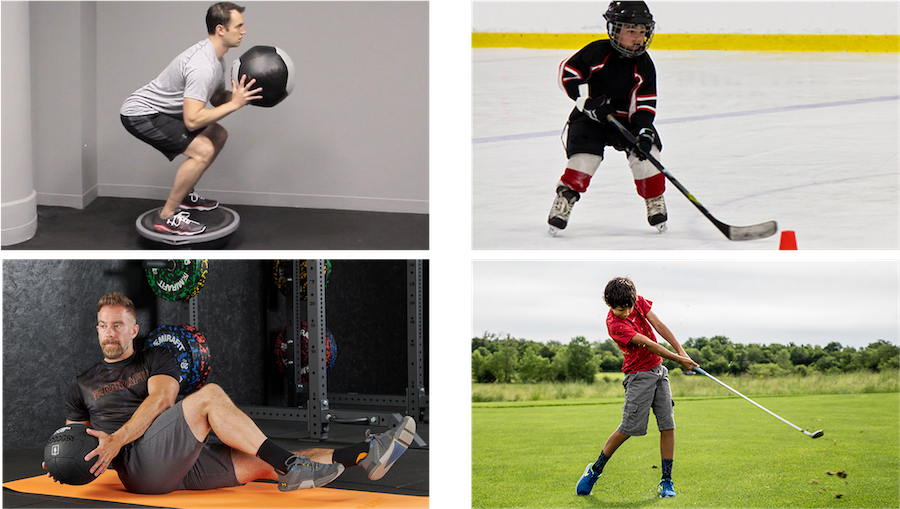
The Puzzle Between Specificity & Overload
Two important training principles to consider are specificity and overload. According to DeWeese et al (2015) (6), specificity can be defined as the degree of metabolic and mechanical similarity between the desired performance characteristics and training exercises. They further state, the aim of increased specificity throughout the training process is to enhance the transfer effect, which is a measure of how much training transfers to actual sport performance. Overload may be more challenging to define, but from the same paper they describe overload as a training stimulus that forces the athlete beyond normal levels of physical performance. Additionally, overload sits closely with the SAID principle – specific adaptations to imposed demands. In other words, if an exercise is performed with enough overload (stimulus) the body (systems) are forced to adapt (improvement in fitness or athlete capabilities), however, the adaptations are only specific to the exercise performed (SAID principle) – thus, adhering to the principles, especially specificity and SAID – the only true sport-specific training is the sport itself!
Therefore, to improve an athlete’s capabilities, overload must be applied, as the stimulus will drive adaptations. If the overload is too low, no further adaptations will occur, so overload is an essential principle. This is the challenge with sport-specific training, undoubtably overload is frequently comprised. For example, if exercises are selected and performed on unstable surfaces, to mimic the same skill or movement pattern (surfers, skateboarders, or skaters) the load is significantly reduced leading to a reduced force output (60 – 70% peak force) (5, 13) additionally – the sensorimotor (balance) has little improvement from the training too.
Conversely, general strength training exercises, for example, squats, deadlifts, lunges, presses, and rows, can be loaded, both at the maximal level (speeds will be low), and moderate loads (speed can be high). By selecting the back squat for strength development, the exercise can be easily overloaded, with other options to vary the exercise – range of motion, emphasise of a muscular contraction, tempo, volume, and rest periods. Less focus is placed on the skill transfer from the exercise, with more attention on improving a physical capacity so that the athlete is more robust (tissue tolerance) and can use this new level of fitness within their sporting practice.
To help coaches with a broader understanding of specificity, Verkhonshanky and Siff (2009) (15), created a five-point criteria, stating that by meeting a set criteria, potentially the exercise may have more transference to a given sport or sporting skill. The criteria is known as Dynamic Correspondence, and from a mechanical perspective, the criteria may help with exercise selection, especially with older-well-trained athletes with higher strength levels, as further gains in general strength may be minimal or reduced. Conversely, younger athletes are frequently untrained (low strength and conditioning training age), thus opening a huge training potential in developing their physical capacities from general exercises, therefore Dynamic Correspondence is probably less important for younger athletes but can useful as they mature and develop.
| Criteria | Practical Examples of the Criteria |
| Amplitude and direction of movement | Describes the range of motion and direction of the movement - force applied. Classic example, bench press and bench row are the same range of motion, but the force is in different directions. |
| Accentuated regions of force production | Describes where in the movement or exercise, (joint position) force is applied. |
| Dynamics of effort | The effort in the training should exceed the sporting movement, as this will adhere to the principle of overload. If the effort is too low adaptations will be minimal to none. |
| Rate and time to maximum force production | As most sporting movements occur within ~300ms, producing maximum force is essential quality within the exercise. Rate of force development will influence net impulse. |
| Regime of muscular work | Different types of muscular contractions - concentric, eccentric, and isometric. Sporting movements tend to use the stretch-shortening cycle. |
Training the Physical Capacities and Skills
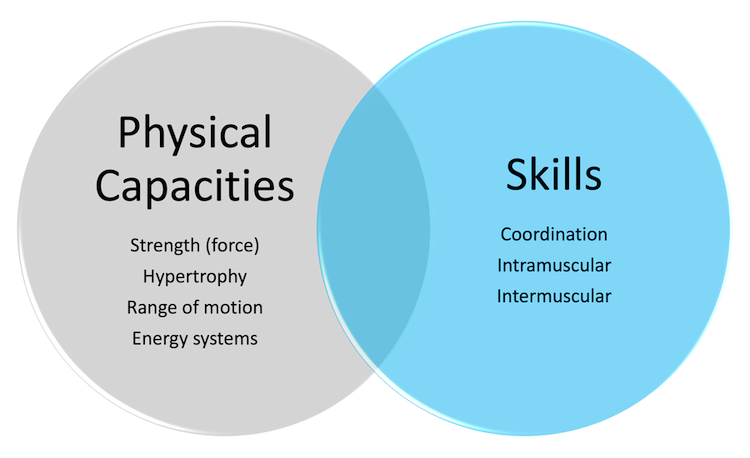
By placing potential training adaptations on a spectrum – physical capacities (strength, hypertrophy, range of motion and conditioning) at one end and skills on the other, this can help coaches select appropriate and effective exercises. Clearly, there will be some overlap in the spectrum, as the body is an organism, and no one system can be trained in complete isolation. However, exercises that can be clearly loaded (overload), with less focus on the sport skills will influence and drive physical capacities, for example strength, hypertrophy, range of motion, and energy systems. Skills on the other hand are on the other side of the spectrum and are underscored by coordination i.e., – inter-muscular and intra-muscular coordination, and speed.
By using a capacity and skill spectrum within exercise selection, the focus can be placed on training a specific capacity (or capacities) first, and then training coordination with more skill-based drills (usually increasing the speed of the exercise). This may also help coaches not to fall into the trap of mimicking the sport or a specific movement pattern - remember we are not trying to copy the sport skill – that’s the sport! Moreover, when the athlete practices their sport, they can practice the skill with a new level of physical capacities (better fitness). This will help the athlete to cope with the demands of the sport skill (robustness) and learn within the sporting environment, how to use their new physical capabilities/fitness.
| Physical Capacities | Skills |
| Exercises can be easily loaded to drive adaptations | Underscored by coordination and speed |
| Strength (maximal or relative) force | Force expression - how force can be expressed within a skill and within a timeframe |
| Hypertrophy - changes in muscle mass/tendon - stiffness | Inter-muscular coordination - how prime movers and other muscles work together |
| Range of motion - the range in which force is applied | Intra-muscular coordination - recruitment of motor units, synchronization, firing frequencies |
| Energy system - aerobic base/recovery | |
|
*Many adaptations from youth athletes (untrained) are neuromuscular so will span across the spectrum. As the athletes develop – more emphasise can be placed on developing their physical capacities. Some exercises/drills can help with skills, but most will come from sport practice (multi-sport). |
|
An example could be an athlete (netball, basketball, or football player) trying to improve their vertical jump, as an effective jumping ability would give them a clear advantage in their sport. Clearly, jumping is now the sport-specific skill, and as the athlete regular jumps in their sport, prescribing more jump volume is not going to drive further adaptations – the exercise or exercises need to overload the athlete’s existing physical capabilities. Therefore, selecting an exercise that recruits the musculature of the hips, knees, and ankles – for example, deadlift, squat, or split squat are great choices, as these exercises can be clearly loaded, plus, the exercise(s) range of motion can be altered to train a particular motion or joint position. By loading the exercise this will drive higher levels of effort from the athlete (stimulus/overload) forcing the musculature to adapt – there will be a cascade of adaptations – neuromuscular and morphologic – depending on the athlete’s training age, maturation, training volume, and nutritional status. So, more than focusing solely on the skill of jumping, the aim of the training can be on overloading the capacities that prepare or will help the athlete as they move towards the skill aspect of training (this could be thought of as indirect transfer).
The next exercise selection may influence more skill development, as stated before, skill can be underscored by coordination, as most skills are performed using many muscle groups and joints at speed (reduce time to express force). Plyometric-type drills are performed relatively quickly, with limited range of motion, as these drills utilise the stretch-shortening cycle, passive structures, and the ability to use potential elastic energy (read more about plyometrics). Getting the athlete to practice plyometric drills, for example tuck jumps, these drills will build upon the new physical capacities and integrate inter/intra-muscular co-ordination (skill and rhythm). Collectively, these training exercises will help the athlete with jump performance characteristics (and potentially reduce the risk of injury due to robustness and the ability to cope with high forces).
Youth Athlete Exercise Selection & Training Development
Young children (pre-peak height velocity) should be introduced to a wide range of movements, activities and games. Emphasis should be placed on free-play and fun. Sports can be introduced, as this can aid in many skills, plus, social interaction, communication skills, and learning simple rules of the game. Clearly, movement skills will be developed throughout the games and activities. As the children mature, more structured exercise or drills can be prescribed. There is no correct age for when a child can start a strength and conditioning programme, this is largely down to when the child can follow instructions – the general rule is – if the child is starting to play sport, they also can start a strength and conditioning programme (10). Furthermore, as children are completely untrained, most adaptations will be neuromuscular (14), hence the recommendations of neuromuscular type training (8).
As the youths move through their maturation, the training can be split between skill-based and strength/resistance training (capacities). If the youth has been exposed to a wide variation of skills, plus some sport skills, it would be reasonable to prioritise more strength training in their strength and conditioning programme. Furthermore, with a relatively low training age, youth athletes will gain lots of positive adaptations from a general physical capacity approach – or, anatomical adaptation phase of training (4). This general phase of training will help bones, muscles, ligaments and other passive tissues adapt, alongside the neuromuscular changes, this will prepare the youths for more aggressive training as they mature and becomes more experienced and skilful (skilful here leaning towards confidence and experience in lifting).
Post-pubertal training, most youth athletes will see large differences in their strength and potentially changes in their bodyweight (peak-weight velocity) – normally 12 months after their initial growth spurt. From regular strength training, at this stage of development, the youths will gain further capacity led adaptations – for example, changes in muscle mass and tendon stiffness, alongside improvements in neuromuscular function. Remember that coordination and skill are closely related, and this is mostly managed by the central nervous system. Through regular training that focuses on general physical capacities, the youth athletes can concentrate on executing the movement with greater intent (changes in rate of force development). Allowing the youth athletes to experience greater intent in their exercises will drive further inter/intra-muscular coordination, which may be an important factor in trying to gain speed/velocity-strength improvements (2) – as seen in most sporting movements (indirect transfer).
We also know that many of the sporting injuries in youths are described as overuse (11), probably resulting from a lack of preparation, too much sport-competition, falling into sport specialisation, and/or using their sport as their training. With this in mind, we clearly don’t want to add more sport-specific training, if anything we need to get the youth athletes away from too much sport practice (especially sport competition), and into training where they can develop general physical capacities and skills – in preparation to practice their sport skills with confidence.
The physical capacity and skills spectrum can be used to help coaches with their exercise selection for youth athletes throughout their physical development. All games, and activities will help with movement skills throughout their physical development. Structured strength training will complement their early skill development and help to enhance their physical capabilities. Trying to mirror, match, or mimic the sport movements are not required and will not lead to better performances or injury reduction.
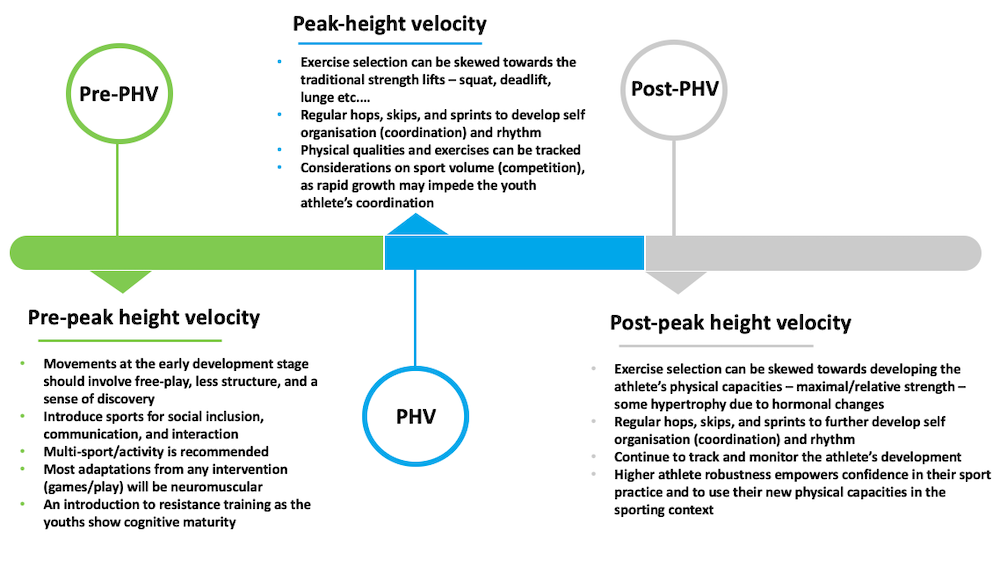
Summary
Athletes train as they want to improve their fitness that hopefully transfers to the sporting arena and aids in high performance (and reduce the risk of injury). Unfortunately, sport-specific training tends to be viewed through a narrow lens, with many coaches trying to load (overload) an exercise/drill that mimics a movement in the sport or looks like a specific movement pattern. Adhering to the SAID principle (specific adaptations to imposed demands), the only valid sport-specific training is the sport itself.
Using a physical capacity and skill-based spectrum to select exercises based on possible adaptations (strength, hypertrophy, range of motion, and energy system) and coordination (inter/intra-muscular) this reduces the confusion surrounding exercise selection and transfer (with most transfer potentially being indirect). If the exercise can be loaded (thus providing an overload to the system), positive adaptations will occur, enhancing the athlete’s overall physical capabilities. Switching to an exercise that is performed quickly/ballistically, this usually moves the exercise towards the skill-based part of the spectrum and drives coordination type adaptations. Transfer can be viewed directly and indirectly, and due to the exercise not being the sport (direct transfer), most transfer will most likely be indirect – better preparation, robustness of the athlete to practice their sport skill, or the athlete has new/higher capacities and will learn to use them in the sport or for a sporting skill.
As youth athletes are frequently untrained, most of the adaptations are neuromuscular, however, as the athlete matures general exercises should be selected to improve their physical capacities (bone, ligament, tendon, and muscular adaptations – anatomical adaptation). If the youth athletes are exposed to a wide range of skills in the early stages of development, this will set a solid foundation for more strength training, especially post-peak height velocity – where strength training can drive a wider spectrum of capacities (hypertrophy – muscle mass, tendon stiffness). Finally, as the main sporting injuries in youths are described as overuse, it would be risky to add more sport-specific type training. Introducing, general exercises, where the athletes can learn, develop, and gain confidence will lead to long-term sport participation, enjoyment, and high performances.
Youth Strength & Conditioning Platform for Schools, Sport Clubs, and Academies.
Our platform helps to deliver effective training and tracks athletic progress and development, with the core objectives of reducing the risk of injuries and to promote both sport readiness and performance. The platform’s features include
- Strength and conditioning tests and dashboard to monitor and compare athlete metrics
- Athlete app - athletes can discover new exercises and train independently
- Track data - monitor athlete’s training loads, RPE, and training adherence
- Reports - simply create squad, team, and individual athlete reports
- Full curriculum - follow a strength and conditioning curriculum with a library of session plans
References
- Ade, J.D., Fitzpatrick, J., & Bradley, P.S. (2016). High-intensity efforts in elite soccer matches and associated movements patterns, technical skills, and tactical actions. Journal of Sports Sciences, 34(24), 2205 – 2214.
- Almasbakk, B., & Hoff, J. (1996). Coordination, the determinant of velocity specificity? Journal of Applied Physiology, 80(5), 2046 – 2052.
- Baker, D. (1996). Improving vertical jump performance through general, special, and specific strength training: a brief review. Journal of Strength & Conditioning Research, 10(2), 131 – 136.
- Bompa, T.O. (1996). Variations of periodisation of strength. Strength & Conditioning, 18(3), 58 – 61.
- Chulvi-Medrano, I., Martinez-Ballester, E., & Masis-Tortosa, L. (2012). Comparison of the effect of an eight-week push-up program using stable versus unstable surfaces. The International Journal of Sports Physical Therapy, 7(6), 586 – 594.
- DeWeese, B.H., Hornsby, G., Stone, M., & Stone, M.H. (2015). The training process: planning for strength-power training in track and field. Part 1: theoretical aspects. Journal of Sport & Health Science, 1 – 10.
- Fossmo, J.E., & Van Den Tillaar, R. (2022). The effects of different relative loads in weight training on acceleration and acceleration from flying starts. Sports, 10(148), 1 – 28.
- Granacher, U., Puta, C., Gabriel, H.H.W., Beham, D.G., & Arampatzis, A. (2018). Editorial: neuromuscular training and adaptations in youth athletes. Frontiers in Physiology, 9(1264), 1 – 5.
- La Scala Teixeira, C.V., Evangelista, A.L., Novaes, J.S., Da Silva Grigoletto, M.E., & Behm, D.G. (2017). You’re only as strong as your weakest link: a current opinion about the concepts and characteristics of functional training. Frontiers in Physiology, 8(643), 1 – 6.
- Myer, G.D., Lloyd, R.S., Brent, J.L., & Faigenbaum, A.D. (2013). How young is too young to start training? ACSM Health & Fitness Journal, 17(5), 14 – 23.
- Paterno, M.V., Taylor-Haas, J.A., Myer, G.D., & Hewett, T.E. (2013). Prevention of overuse sports injuries in the young athlete. Orthop Clin North Am, 44(4), 553 – 564.
- Shaw, I., Shaw, B.S., Brown, G.A., & Shariat, A. (2016). Review of the role of resistance training and musculoskeletal injury prevention and rehabilitation. Journal of Orthopaedic Research and Therapy, 1, 1 – 5.
- Tran, T.T., Nimphius, S., Lundgren, L., Secomb, J., Farley, O.R.L., Haff, G.G., Newton, R.U., Brown, L.E., & Sheppard, J.M. (2015). Effects of unstable and stable resistance training on strength, power, and sensorimotor abilities in adolescent surfers. International Journal of Sports Science & Coaching, 10(5), 899 – 909.
- Tumkur Anil Kumar, N., Oliver, J., Lloyd, R.S., Pedley, J.S., & Radnor, J.M. (2021). The influence of growth, maturation and resistance training on muscle-tendon and neuromuscular adaptations: a narrative review. Sports, 9(59), 1 – 24.
- Verkhoshansky, Y., & Siff, M.C. (2009). Supertraining. SSTM, Rome, Italy, 241 – 248.
- Young, W.B. (2006). Transfer of strength and power training to sports performance. International Journal of Sports Physiology & Performance, 1, 74 – 83.
